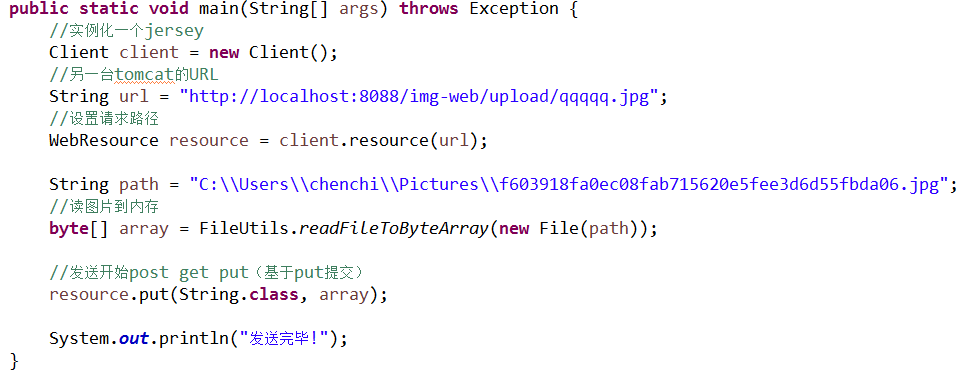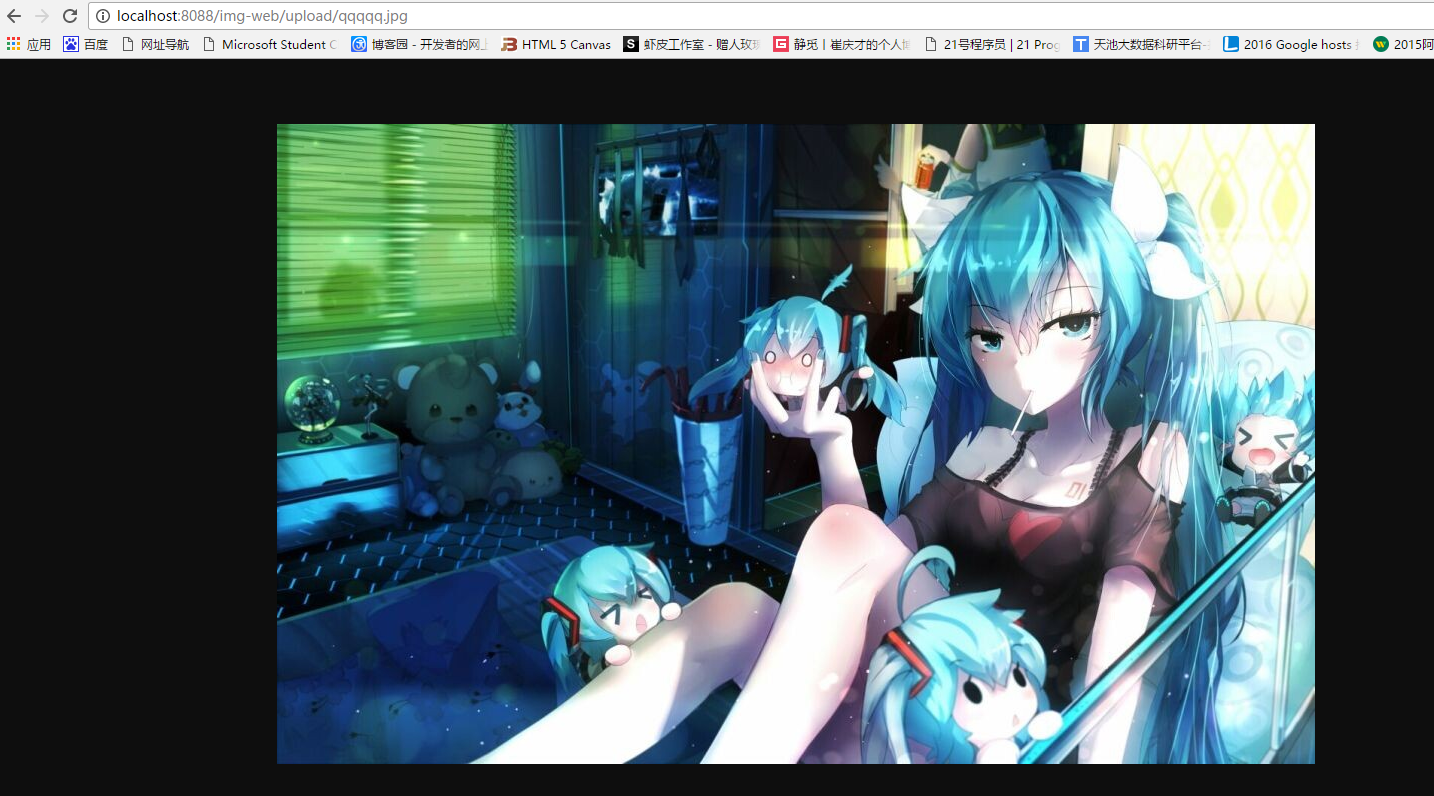通过一个SpringMVC的案例加以说明。
1.打开按钮是什么事件(前端页面)
<form id="jvForm" action="o_save.shtml" method="post" enctype="multipart/form-data"> <tr> <td width="20%" class="pn-flabel pn-flabel-h"></td> <td width="80%" class="pn-fcontent"> <img width="100" height="100" id="allImgUrl"/> <!-- 方便提交给后台,存到数据库 --> <input type="hidden" name="" id="path"/> <input type="file" onchange="uploadPic()" name="pic"/> </td> </tr> </form>
enctype不能丢。
引入相关库:
<script src="/sport/res/common/js/jquery.js" type="text/javascript"></script> <script src="/sport/res/common/js/jquery.ext.js" type="text/javascript"></script> <script src="/sport/res/common/js/jquery.form.js" type="text/javascript"></script>
2.异步提交ajax是怎么把图片上传到后台服务器的(JS代码)
<script type="text/javascript"> //上传图片 function uploadPic(){ //定义参数 var options = { url:"/sport/upload/uploadPic.do", type:"post", dataType:"json", success:function(data){ //回调两个路径 //url $("#allImgUrl").attr("src", data.url); //path $("#path").val(data.path); } }; //jquery.form使用方式 $("#jvForm").ajaxSubmit(options); } </script>
3.配置springmvc支持上传图片功能
<!-- 上传图片 --> <bean id="multipartResolver" class="org.springframework.web.multipart.commons.CommonsMultipartResolver"> <!-- 最大上传尺寸 B 1M --> <property name="maxUploadSize" value="1048576"/> </bean>
4.搭建一个图片服务器
复制一份tomcat,在tomcat/conf/web.xml中内容如下更改,使其可读写。
<servlet> <servlet-name>default</servlet-name> <servlet-class>org.apache.catalina.servlets.DefaultServlet</servlet-class> <init-param> <param-name>debug</param-name> <param-value>0</param-value> </init-param> <init-param> <param-name>readonly</param-name> <param-value>false</param-value> </init-param> <init-param> <param-name>listings</param-name> <param-value>false</param-value> </init-param> <load-on-startup>1</load-on-startup> </servlet>
在tomcat/conf/server.xml进行3个端口的修改。

在这里可能会遇到第二台修改端口不生效的情况,建议参看另一篇博客:http://www.cnblogs.com/DarrenChan/p/6889990.html
5.发送此图片到另外一台服务器
利用jersey进行发送。首先我们看一下jersey的一个demo。
程序用到3个jar包,如下:


在这里,我把我本地的图片发送到了第二台tomcat上。然后我可以直接通过网址访问该图片,如下:

同理,在web项目中,我们写一个Controller,在写之前我先把需要的工具类写一个,利用response发送不同类型的数据。

package cn.darrenchan.common.web; import java.io.IOException; import javax.servlet.http.HttpServletResponse; public class ResponseUtils { //发送内容 public static void render(HttpServletResponse response, String contentType, String text){ response.setContentType(contentType); try { response.getWriter().write(text); } catch (IOException e) { e.printStackTrace(); } } //发送json public static void renderJson(HttpServletResponse response, String text){ render(response, "application/json;charset=utf-8", text); } //发送xml public static void renderXml(HttpServletResponse response, String text){ render(response, "text/xml;charset=utf-8", text); } //发送text public static void renderText(HttpServletResponse response, String text){ render(response, "text/plain;charset=utf-8", text); } }
重点在于Controller。
package cn.darrenchan.core.controller; import java.io.File; import java.io.FileInputStream; import java.io.FileNotFoundException; import java.io.IOException; import java.util.UUID; import javax.servlet.http.HttpServletResponse; import org.apache.commons.io.FileUtils; import org.apache.commons.io.FilenameUtils; import org.json.JSONObject; import org.springframework.stereotype.Controller; import org.springframework.web.bind.annotation.RequestMapping; import org.springframework.web.bind.annotation.RequestParam; import org.springframework.web.multipart.MultipartFile; import com.sun.jersey.api.client.Client; import com.sun.jersey.api.client.ClientHandlerException; import com.sun.jersey.api.client.UniformInterfaceException; import com.sun.jersey.api.client.WebResource; import cn.darrenchan.common.web.ResponseUtils; /** * 上传图片 * * @author chenchi * */ @Controller public class UploadController { // 上传图片,false表示不上传也可以不报错 @RequestMapping(value = "/upload/uploadPic.do") public void uploadPic(@RequestParam(required = false) MultipartFile pic, HttpServletResponse response) { // 图片名称生成策略 UUID uuid = UUID.randomUUID(); // 获取图片的扩展名 String extension = FilenameUtils.getExtension(pic.getOriginalFilename()); // 实例化一个jersey Client client = new Client(); // 保存到数据库的path String path = "upload/" + uuid + "." + extension; // 另一台tomcat的URL String url = "http://localhost:8088/img-web/" + path; // 设置请求路径 WebResource resource = client.resource(url); // 发送开始post get put(基于put提交) try { resource.put(String.class, pic.getBytes()); } catch (IOException e) { e.printStackTrace(); } //返回两个路径 JSONObject jo = new JSONObject(); jo.put("url", url); jo.put("path", path); ResponseUtils.renderJson(response, jo.toString()); System.out.println(pic.getOriginalFilename());// afsdfdsfsd.jpg System.out.println(111); } }
6.将path路径保存到数据库中
补充:
1.
<input class="add" type="button" value="添加" onclick="javascript:window.location.href='/sport/brand/toAdd.do'" />
2.select的写法
<select name="isDisplay"> <option value="1" <c:if test="${isDisplay == 1 }">selected="selected"</c:if>>是</option> <option value="0" <c:if test="${isDisplay == 0 }">selected="selected"</c:if>>不是</option> </select>
3.EL表达式中的三元运算符
${entry.isDisplay == 0 ? '不是':'是' }
4.jsp中获取项目名称
action="${pageContext.request.contextPath}/brand/edit.do"
如果报错,就将jsp-api.jar和servlet-api.jar 一起添加到项目中,这两个jar包在tomcat的lib文件夹下可找到。
5.jsp模板
<%@page pageEncoding="utf-8"%> <!doctype html> <html> <head> <meta charset="utf-8" /> <title>登录</title> </head> <body> <h1>login successfully!</h1> <h1>${message}</h1> <h1>${username}</h1> <h1>${password }</h1> </body> </html>
6. 利用<a>标签做删除
<a class="pn-opt" onclick="if(!confirm('您确定删除吗?')) {return false;} window.location.href='/sport/brand/delete.do?id=${entry.id }&name=${name}&isDisplay=${isDisplay}'" href="javascript:void(0)">删除</a>
7.传统JSP写法
<% if (session.getAttribute("userName") != null) {%> 欢迎: <%= session.getAttribute("userName") %> <a href = "login.jsp">注销</a> <br/> <% } else { %> 请先登陆 <a href = "login.jsp">登陆</a> <% } %>
等价于
if (session.getAttribute("userName") != null) { out.write(" "); out.write(" 欢迎: "); out.print( session.getAttribute("userName") ); out.write(" "); out.write(" <a href = "login.jsp">注销</a> "); out.write(" <br/> "); out.write(" "); } else { out.write(" "); out.write(" 请先登陆 "); out.write(" <a href = "login.jsp">登陆</a> "); out.write(" "); } out.write(" "); out.write(" "); out.write(" ");
<%=变量 %> 是 <% out.println(变量) %> 的简写方式
